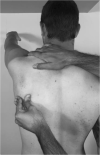Scapular Dyskinesis and the Kinetic Chain: Recognizing Dysfunction and Treating Injury in the Tennis Athlete
- PMID: 32827302
- PMCID: PMC7661674
- DOI: 10.1007/s12178-020-09672-6
Scapular Dyskinesis and the Kinetic Chain: Recognizing Dysfunction and Treating Injury in the Tennis Athlete
Abstract
Purpose of review: This article aims to provide a comprehensive understanding of the evaluation, diagnosis, and management of scapular dyskinesis and its impact on the kinetic chain in tennis athletes.
Recent findings: Optimal glenohumeral biomechanics are intimately associated with proper scapular motion and function. The tennis serve requires the scapula to act as a force transducer in the kinetic chain to convert potential energy generated in the lower extremities to kinetic energy in the upper extremity. Any aberration within this complex kinetic chain will result in force uncoupling and increases the potential for injury through compensatory mechanisms. Specifically, scapular dyskinesis has been associated with an increased risk of shoulder pain of up to 43% in overhead athletes. These pathologies include rotator cuff disease, subacromial and posterior impingement, labral injuries, and SLAP tears. Although the direct causality of these injuries remains controversial, multiple kinematic studies have demonstrated altered scapular positioning increasing the predilection for soft tissue pathology. The diagnosis of scapular dyskinesis is predicated upon a thorough history, physical examination, and observational analysis of key nodes in the kinetic chain during tennis activity. Conservative management remains the mainstay of treatment and consists of a graduated physical therapy regimen. Although shoulder pain in the overhead athletes is often multifactorial, early recognition and treatment of scapular dyskinesis generally carry a favorable prognosis and result in improved patient outcomes.
Keywords: Scapular dyskinesis; Shoulder pain in the tennis athlete; Tennis kinetic chain; Tennis nodes.
Conflict of interest statement
Sundeep S. Saini, Sarav S. Shah, and Alan S. Curtis declare that they have no conflicts of interest pertinent to this paper.
Figures
References
-
- Lehman RC. Shoulder pain in the competitive tennis player. Clin Sports Med. 1988;7(2):309–327. - PubMed
-
- Abrams GD, Renstrom PA, Safran MR. Epidemiology of musculoskeletal injury in the tennis player. Br J Sports Med. 2012;46(7):492–498. - PubMed
-
- Hutchinson MR, Laprade RF, Burnett QM, 2nd, Moss R, Terpstra J. Injury surveillance at the USTA Boys’ Tennis Championships: a 6-yr study. Med Sci Sports Exerc. 1995;27(6):826–830. - PubMed
-
- Winge S, Jorgensen U, Lassen NA. Epidemiology of injuries in Danish championship tennis. Int J Sports Med. 1989;10(5):368–371. - PubMed
Publication types
LinkOut - more resources
Full Text Sources
Research Materials







